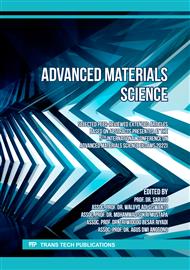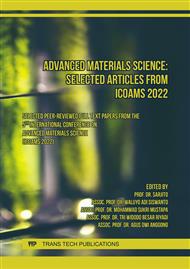[1]
A. K. Yadav and R. Srivastava, Mechanical and Hygroscopic Behaviour of Teak Wood Sawdust Filled Recycled Polypropylene Composites, vol. 31, 5 (2018). 202–208.
Google Scholar
[2]
B. Lela, M. Barišić, and S. Nižetić, Cardboard/sawdust briquettes as biomass fuel: Physical-mechanical and thermal characteristics, Waste Manag., vol. 47, (2016) 236–245.
DOI: 10.1016/j.wasman.2015.10.035
Google Scholar
[3]
C. Antwi-Boasiako and B. B. Acheampong, Strength properties and calorific values of sawdust-briquettes as wood-residue energy generation source from tropical hardwoods of different densities, Biomass and Bioenergy, vol. 85, (2016) 144–152.
DOI: 10.1016/j.biombioe.2015.12.006
Google Scholar
[4]
M. Estrada-Jaramillo, I. Vera-Romero, J. Martínez-Reyes, A. Ortíz-Soriano, and E. Barajas-Ledesma, Empirical Model to Calculate the Thermodynamic Wet-Bulb Temperature of Moist Air, Engineering, vol. 06, 09 (2014) 500–506.
DOI: 10.4236/eng.2014.69052
Google Scholar
[5]
R. Stull, Wet-bulb temperature from relative humidity and air temperature, J. Appl. Meteorol. Climatol., vol. 50, 11 (2011) 2267–2269.
DOI: 10.1175/jamc-d-11-0143.1
Google Scholar
[6]
Z. Z. Chowdhury, M. Ziaul Karim, M. A. Ashraf, and K. Khalid, Influence of carbonization temperature on physicochemical properties of biochar derived from slow pyrolysis of durian wood (Durio zibethinus) sawdust, BioResources, vol. 11, 2 (2016) 3356–3372.
DOI: 10.15376/biores.11.2.3356-3372
Google Scholar
[7]
P. Sundaram, P. Sudhakar, and R. Yogeshwaran, Experimental Studies and Mathematical Modeling of Drying Wheat in Fluidized Bed Dryer, Indian J. Sci. Technol., vol. 9, 36 (2016).
DOI: 10.17485/ijst/2016/v9i36/93696
Google Scholar
[8]
D. C. Chinyere, The International Journal Of Science & Technoledge An Evaluation of Briquettes from Sawdust and Corn Starch Binder Abstract, vol. 2, 7 (2014) 149–157.
Google Scholar
[9]
Musabbikhah, H. Saptoadi, Subarmono, and M. A. Wibisono, Modelling and optimization of the best parameters of rice husk drying and carbonization by using Taguchi method with multi response signal to noise procedure, Int. J. Renew. Energy Res., vol. 7, 3 (2017) 1219–1227.
DOI: 10.20508/ijrer.v7i3.5980.g7190
Google Scholar
[10]
B. N. Madanayake, S. Gan, C. Eastwick, and H. K. Ng, Leaching as a Pretreatment Process to Complement Torrefaction in Improving Co-firing Characteristics of Jatropha curcas Seed Cake, Waste and Biomass Valorization, vol. 7, 3 (2016) 559–569.
DOI: 10.1007/s12649-015-9467-z
Google Scholar
[11]
M. Wilk, A. Magdziarz, I. Kalemba, and P. Gara, Carbonisation of wood residue into charcoal during low temperature process, Renew. Energy, vol. 85, (2016) 507–513.
DOI: 10.1016/j.renene.2015.06.072
Google Scholar
[12]
P. Payakkawan, S. Areejit, and P. Sooraksa, Design, fabrication and operation of continuous microwave biomass carbonization system, Renew. Energy, vol. 66, (2014) 49–55.
DOI: 10.1016/j.renene.2013.10.042
Google Scholar
[13]
P. Kalyani and A. Anitha, Biomass carbon & its prospects in electrochemical energy systems, Int. J. Hydrogen Energy, vol. 38, 10 (2013) 4034–4045.
DOI: 10.1016/j.ijhydene.2013.01.048
Google Scholar
[14]
and R. K. A. Ohliger., M. Förster., Torrefaction of beechwood: A parametric Study Including Heat of Reaction and Grindability, Fuel., vol. 104, (2013) 607–613.
DOI: 10.1016/j.fuel.2012.06.112
Google Scholar
[15]
L. Slupik, A. Fic, Z. Bulinski, A. J. Nowak, J. Smolka, and L. Kosyrczyk, Sensitivity analysis of the computational model of the coal carbonisation process, Appl. Therm. Eng., vol. 114, (2017). 1002–1013.
DOI: 10.1016/j.applthermaleng.2016.12.050
Google Scholar
[16]
S. B. Musabbikhah, Optimizing the Pyrolysis Process and Modelling the Calorific Value of Sawdust Charcoal as Composing Materials of Quality Briquettes, (2019)263–267.
DOI: 10.5220/0009882402630267
Google Scholar
[17]
M. Ahiduzzaman and A. K. M. Sadrul Islam, Assessment of rice husk briquette fuel use as an alternative source of woodfuel, Int. J. Renew. Energy Res., vol. 6, 4 (2016) 1601–1611.
DOI: 10.20508/ijrer.v6i4.4854.g6948
Google Scholar
[18]
J. Almedeij, Modeling pan evaporation for kuwait by multiple linear regression, Sci. World J., (2012).
DOI: 10.1100/2012/574742
Google Scholar
[19]
R. S. Society, On Parametric Bootstrap Methods for Small Area Prediction Author (s): Peter Hall and Tapabrata Maiti Source : Journal of the Royal Statistical Society, (2006) 221–238.
DOI: 10.1111/j.1467-9868.2006.00541.x
Google Scholar
[20]
M. Vishwakarma, V. Parashar, and V. K. Khare, Experimental Investigation and Optimization of Material Removal Rate on Electric Discharge Machine for EN-19 Alloy Steel using Copper, vol. 7, 12 (2012) 1457–1467.
Google Scholar
[21]
Musabbikhah, S. Putro, and S. Bakhri, The Effect of Particle Size, Pressure, Holding Time and Drying Temperature to the Physical and Mechanical Properties of Briquettes, Mater. Sci. Forum, vol. 1051 (2022) 79–86.
DOI: 10.4028/www.scientific.net/msf.1051.79
Google Scholar



